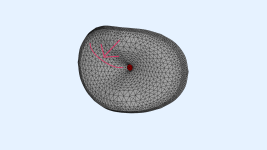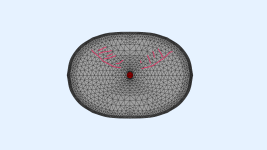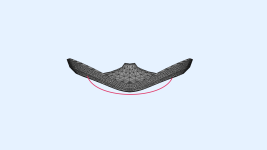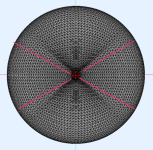Wikipedia usually has a concise definition on things, with sources https://en.wikipedia.org/wiki/Transient_(acoustics)
I have a follow-up question from yesterday: The asymmetric profile is generated with the use of x*sin(p)^2. So all manipulation is changing with the angle. This does work to some extend, but for a more proper design, I would need to extend the vertical manipulation further, thus somewhat giving a higher weighting to the middle angles between 0 and 90 degree. Is there currently a way in ath how I can define this? Here is an illustration of what I mean:






Code:R-OSSE = { R = 160 - 50*sin(p)^2 r0 = 8 a0 = 10.85 a = 60 -18*sin(p)^2 k = 0.4 + 2.5*sin(p)^2 r = 0.18 - 0.07*cos(p)^2 + 0.05*sin(p)^2 b = 1.2 + 0.2*cos(p)^2 - 0.8*sin(p)^2 m = 0.8 q = 5 + 1*cos(p)^2 + 3*sin(p)^2 }
Last edited:
If the possbility of changing anything with angle is not enough for you, I'm afraid it's all that can be done. But you can use expressions more complex than the most simple ones you use currently - you can change the period(s), use higher exponents for sin(), add more different terms, etc. If you were tireless enough, you could build something like a FFT series for basically anything (adding up different sines along the circumference, the same way as harmonics add in a signal). Desmos is a great tool for this.
Also, by using functions like floor() I believe it's possible to add even a simple logic to the expressions ("if angle > X then ...").
https://at-horns.eu/release/Ath-4.8.2-UserGuide.pdf#page=63
I'd try to work more with a0 in combination with k perhaps on the vertical. You really don't want a to be less than a0 anywhere...
Also, by using functions like floor() I believe it's possible to add even a simple logic to the expressions ("if angle > X then ...").
https://at-horns.eu/release/Ath-4.8.2-UserGuide.pdf#page=63
I'd try to work more with a0 in combination with k perhaps on the vertical. You really don't want a to be less than a0 anywhere...
Last edited:
Changing anything with angle is good, it is probably just too complicated for me to understand how everything translates into shape. Maybe in a couple of years, when someone created the GUI ath with a wysiwyg editor 🙂
What do you mean by that?You really don't want a to be less than a0 anywhere...
Try desmos 3D tool, I think it can visualize the shape real time, provide sliders for parameters and you just tweak the equations and params and see what happens 🙂 Well, not sure what the complete math is, might be in the papers, haven't checked them a while... Perhaps mabat has an example to share?
https://www.desmos.com/3d
https://www.desmos.com/3d
That it's not good to have wall slope decreasing anywhere. From your pictures I'd say that you want to decrease a0, a and increase k in the vertical. In how narrow angle interval is controlled by the sine exponent (2, 4, 6, ...). And perhaps something else as well but cut&try is all there is at the moment.What do you mean by that?
But I suspect you would be dissapointed with the performance.
No experience on the 3D tool, but it looks intuitive at least 🙂
https://help.desmos.com/hc/en-us/articles/19796006153997-Getting-Started-Desmos-3D
https://www.desmos.com/3d-gallery
One can get pretty wild with Desmos 😀
https://www.desmos.com/art-2023#17
https://help.desmos.com/hc/en-us/articles/19796006153997-Getting-Started-Desmos-3D
https://www.desmos.com/3d-gallery
One can get pretty wild with Desmos 😀
https://www.desmos.com/art-2023#17
You can start with my year-old example of R-OSSE in 3D:
- https://www.desmos.com/3d/970a1eea44
- https://www.desmos.com/3d/970a1eea44
Last edited:
If you wanted to apply some modification only on vertical in a different way than via a simple sin(), this is also possible:
https://www.desmos.com/calculator/aeckbk2omu
https://www.desmos.com/calculator/zfuratc4dz
Only beware that the angles in the Ath script expressions are expected in radians, I think (so use pi/2 instead of 90).


https://www.desmos.com/calculator/aeckbk2omu
https://www.desmos.com/calculator/zfuratc4dz
Only beware that the angles in the Ath script expressions are expected in radians, I think (so use pi/2 instead of 90).
Last edited:
So this is the expression you would need to multiply your modifier with:

(p0, p1, n are additional parameters - see the Desmos examples above)
Maybe I could also define this as a new available function.
(p0, p1, n are additional parameters - see the Desmos examples above)
Maybe I could also define this as a new available function.
Last edited:
It will certainly allow all kinds of "new" stuff -



The above is simply "a = 38 - 10*trw(0.9,1.2,2,p)", trw() being the function devised above.
I'll update the Ath executable on my web in a moment.
The above is simply "a = 38 - 10*trw(0.9,1.2,2,p)", trw() being the function devised above.
I'll update the Ath executable on my web in a moment.
k = 1 + 8*trw(0.9,1.2,2,p)

Imagine all the combinations possible.
Imagine all the combinations possible.
k = 1 + 8*trw(0.7,1.4,1,p)*sin(p)


Symmetric face!🙂 In addition you might be able to add slight "diffraction slot", IOW start horizontal wideing of the profile bit further from the throat than the vertical. Consider similar sine function to the throat extension, if you wish to make even more asymmetric nominal coverage pattern. I don't know how would it work, probably just some more math 🙂
You can easily try it: https://at-horns.eu/ext/ath-2024-11a.zip
There are two new weighting functions for this:
trwu(p0, p1, n, p) ... transition from 0 to 1 at the interval <p0, p1>
trwd(p0, p1, n, p) ... transition from 1 to 0 at the interval <p0, p1>
The angles p0 and p1 are in radians (= deg * pi/180).
To apply a modifier with the transition starting at 30 deg (=0.5236 rad) it would be e.g.: trwu(0.5236, 0.8, 2, p)
The parameter n controls the shape of the transition (see an example).

There are two new weighting functions for this:
trwu(p0, p1, n, p) ... transition from 0 to 1 at the interval <p0, p1>
trwd(p0, p1, n, p) ... transition from 1 to 0 at the interval <p0, p1>
The angles p0 and p1 are in radians (= deg * pi/180).
To apply a modifier with the transition starting at 30 deg (=0.5236 rad) it would be e.g.: trwu(0.5236, 0.8, 2, p)
The parameter n controls the shape of the transition (see an example).
Last edited:
a = 39 - 18*trwu(0.2,0.9,1,p)*sin(p)





Too much constant.. 🙂
Too much constant.. 🙂
Last edited:
- Home
- Loudspeakers
- Multi-Way
- Acoustic Horn Design – The Easy Way (Ath4)
